| Listing 1 - 10 of 18 | << page >> |
Sort by
|
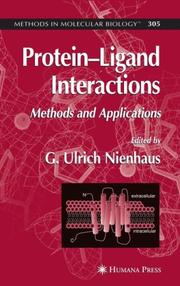
ISSN: 10643745 ISBN: 1588293726 9786610359134 1280359137 1592599125 9781588293725 Year: 2005 Volume: 305 Publisher: Clifton, NJ : Humana Press,
Abstract | Keywords | Export | Availability | Bookmark
 Loading...
Loading...Choose an application
- Reference Manager
- EndNote
- RefWorks (Direct export to RefWorks)
Molecular recognition and binding of ligands (atoms, ions, and molecules) by proteins with high sensitivity and selectivity is of central importance to essentially all biomolecular processes and of key importance for the basic and applied sciences. In Protein-Ligand Interactions: Methods and Applications, leading experts with hands-on experience describe in detail a broad selection of established and emerging techniques for studying the interaction between proteins and ligands, including bulk biochemical techniques, structure analysis, spectroscopy, single-molecule studies, and theoretical/computational tools. Among the highlights are surface plasmon resonance (SPR) and reflectometric biosensor approaches, high-throughput screening with confocal optics microscopy, single molecule fluorescence and fluorescence correlation spectroscopy (FCS), atomic force microscopy (AFM), crystallography of reaction intermediates, and time-resolved X-ray crystallography. The protocols follow the successful Methods in Molecular Biology™ series format, each offering step-by-step laboratory instructions, an introduction outlining the principle behind the technique, lists of the necessary equipment and reagents, and tips on troubleshooting and avoiding known pitfalls. Cutting-edge and highly practical, Protein-Ligand Interactions: Methods and Applications offers novice and expert researchers alike a broad selection of powerful and widely applicable techniques that can be used to efficiently and successfully solve the task of characterizing protein-ligand interactions.
Protein binding --- Ligands --- Proteins --- Chemistry Techniques, Analytical --- Protein Binding --- chemistry --- methods --- Chemistry, Analytic -- Laboratory manuals. --- Protein binding -- Laboratory manuals. --- Laboratory Chemicals --- Specialty Uses of Chemicals --- Binding, Protein --- Chemistry, Analytic --- Biochemistry --- Allosteric proteins --- Radioligand assay --- Biochemistry. --- Biochemistry, general. --- Biological chemistry --- Chemical composition of organisms --- Organisms --- Physiological chemistry --- Biology --- Chemistry --- Medical sciences --- Composition --- Protein binding - Laboratory manuals --- Ligands - laboratory manuals --- Proteins - chemistry - Laboratory Manuals --- Chemistry Techniques, Analytical - methods - laboratory manuals --- Protein Binding - Laboratory Manuals
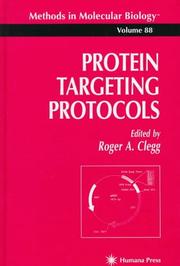
ISBN: 1280843055 9786610843053 1592595723 0896034879 089603450X Year: 1998 Publisher: Totowa, NJ : Humana Press : Imprint: Humana,
Abstract | Keywords | Export | Availability | Bookmark
 Loading...
Loading...Choose an application
- Reference Manager
- EndNote
- RefWorks (Direct export to RefWorks)
In Protein Targeting Protocols, master experimentalists describe, largely from the perspective of intracellular signaling, their best time-tested methods for detecting and analyzing the proteins and protein motifs involved in cellular targeting interactions. The techniques range from basic methods that reveal the existence of targeting interactions and characterize physicochemical properties to those for analyzing the more structurally elaborate systems involved in the movement of molecules between cellular compartments, with examples taken from nuclear transport, clathrin-coated vesicle traffic, and secretory sorting. The themes of targeting domains, particularly the SH-2, SH-3, and PH domains, and the principal targeting of lipid modifications-myristoylation, reversible palmitoylation, prenylation-are fully explored. Protein Targeting Protocols offers a valuable collection of both basic and state-of-the-art techniques suitable for use in all areas of molecular cell biology by researchers interested in defining and characterizing the wide variety of protein interactions underlying targeting mechanisms. Readers will find it serves well as a firm methodological foundation for laboratories newly entering this field and as an indispensable reference work for those already well-established in it.
Biochemistry. --- Biochemistry, general. --- Biological chemistry --- Chemical composition of organisms --- Organisms --- Physiological chemistry --- Biology --- Chemistry --- Medical sciences --- Composition --- Protein binding --- Research --- Laboratory manuals.
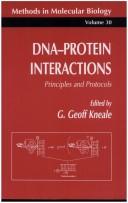
ISBN: 0896032566 1592595170 9780896032569 Year: 1994 Volume: 30 Publisher: Totowa : Humana Press,
Abstract | Keywords | Export | Availability | Bookmark
 Loading...
Loading...Choose an application
- Reference Manager
- EndNote
- RefWorks (Direct export to RefWorks)
The study of protein-nucleic acid interactions is currently one of the most rapidly growing areas of molecular biology. DNA binding proteins are at the very heart of the regulation and control of gene expression, replication, and recombination: Enzymes that recognize and either modify or cleave specific DNA sequences are equally important to the cell. Some of the techniques reported in this volume can be used to identify previously unknown DNA binding proteins from crude cell extracts. Virtually all are capable of giving direct information on the molecular basis of the interaction—the location of the DNA binding site; the strength and specificity of binding; the identities of individual groups on specific bases involved in binding; the specific amino acid residues of the protein that interact with the DNA; or the effects of protein binding on gross conformation and local structure of DNA. The recognition of DNA sequences by proteins is a complex phenomenon, involving specific hydrogen bonding contacts to the DNA bases ("direct readout") and/or interactions with the sugar-phos phate backbone ("indirect readout"). The latter interactions can also be highly specific because of sequence-dependent conformational changes in the DNA. In addition, intercalation of planar aromatic amino acid side-chains between the DNA bases can occur, most notably with single-stranded DNA binding proteins. Furthermore, when bound, many DNA binding proteins induce drastic structural changes in the DNA as an integral part of their function.
DNA-protein interactions --- ADN --- DNA --- Protéine --- proteins --- Acide nucléique --- Nucleic acids --- Protéine de liaison --- Binding proteins --- Synthèse protéique --- protein synthesis --- DNA-protein interactions. --- Electronic books. -- local. --- Protein binding. --- Genetic Techniques --- DNA-Binding Proteins --- Proteins --- Investigative Techniques --- Amino Acids, Peptides, and Proteins --- Analytical, Diagnostic and Therapeutic Techniques and Equipment --- Chemicals and Drugs --- Animal Biochemistry --- Human Anatomy & Physiology --- Health & Biological Sciences --- DNA-protein binding --- Interactions, DNA-protein --- Protein-DNA interactions --- DNA-ligand interactions --- Protein binding --- Binding, Protein --- Biochemistry --- Allosteric proteins --- Radioligand assay --- DNA. --- Biochemistry. --- Biochemistry, general. --- Biological chemistry --- Chemical composition of organisms --- Organisms --- Physiological chemistry --- Biology --- Chemistry --- Medical sciences --- Composition
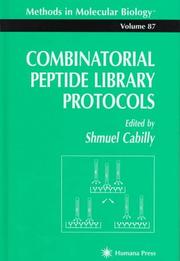
ISBN: 0896033929 9786610836871 1280836873 1592595715 9780896033924 Year: 1998 Volume: 87 Publisher: Totowa, NJ : Humana Press : Imprint: Humana,
Abstract | Keywords | Export | Availability | Bookmark
 Loading...
Loading...Choose an application
- Reference Manager
- EndNote
- RefWorks (Direct export to RefWorks)
Shmuel Cabilly presents in Combinatorial Peptide Library Protocols a collection of new and unique techniques for the construction and use of peptide libraries. These powerful methods-often detailed here by their pioneers-include protocols for the chemical synthesis of peptide libraries, for constructing peptide libraries that are displayed on the surface of filamentous phage or bacteria, and for the rapid screening of these libraries for molecules with biospecific properties. Additional methods permit identifying specific enzyme substrates, investigating the recognition spectra of various binding proteins, epitope mapping, and identifying mimotopes. Combinatorial Peptide Library Protocols offers novice and experienced investigators alike the ability to select molecules from a randomized pool having specific biological activities. Its state-of-the-art techniques, combined with clear step-by-step instructions, make this book an essential tool in the selection of peptides suitable for drug development.
Protein binding --- Combinatorial chemistry --- Peptides --- Synthesis --- Protein Binding --- Peptide Library --- Molecular Sequence Data --- Gene Library --- Amino Acids, Peptides, and Proteins --- Metabolism --- Amino Acid Sequence --- Biochemical Processes --- Documentation --- Genetic Structures --- Chemical Processes --- Chemicals and Drugs --- Information Services --- Metabolic Phenomena --- Molecular Structure --- Biochemical Phenomena --- Phenomena and Processes --- Information Science --- Genetic Phenomena --- Chemical Phenomena --- Animal Biochemistry --- Human Anatomy & Physiology --- Health & Biological Sciences --- Combinatorial chemistry. --- Protein binding. --- Synthesis. --- Life sciences. --- Biochemistry. --- Life Sciences. --- Biochemistry, general. --- Biological chemistry --- Chemical composition of organisms --- Organisms --- Physiological chemistry --- Biology --- Chemistry --- Medical sciences --- Biosciences --- Sciences, Life --- Science --- Composition --- Binding, Protein --- Biochemistry --- Allosteric proteins --- Radioligand assay --- Combinatorial organic synthesis --- Combinatorial synthesis (Organic chemistry) --- High-throughput organic synthesis --- High-throughput synthesis (Organic chemistry) --- Multiple parallel synthesis (Organic chemistry) --- Organic compounds --- Pharmaceutical chemistry --- Biochips --- Peptide synthesis --- Peptides - Synthesis
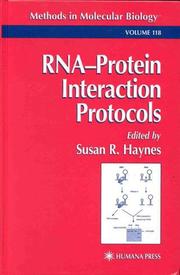
ISBN: 0896035689 9786610831517 1280831510 1592596762 Year: 1999 Volume: 118 Publisher: Totowa Humana press
Abstract | Keywords | Export | Availability | Bookmark
 Loading...
Loading...Choose an application
- Reference Manager
- EndNote
- RefWorks (Direct export to RefWorks)
In RNA-Protein Interaction Protocols, highly skilled experimentalists provide a comprehensive series of commonly used, as well as specialized, techniques for analyzing how proteins and RNA interact. Richly detailed and readily reproducible, these methods enable researchers to analyze the structural details of an RNA-protein interaction, to determine in detail what parts of the protein and RNA are in close contact, and to isolate RNP complexes from cells. There are also in vitro and in vivo methods and protocols for assaying the effects of proteins and RNP complexes on mRNA metabolism. The methods assume only a knowledge of basic molecular biology, biochemistry, and cell culture, and can be readily adapted to other systems. Providing an excellent standard resource for today's bench scientists studying many types of RNA-protein interactions, RNA-Protein Interaction Protocols offers a wide-ranging collection of up-to-date experimental methods that distill a great deal of wisdom and experience into productive, reproducible, step-by-step techniques for all investigators in the field.
RNA-protein interactions --- Interactions ARN-protéines --- Laboratory manuals. --- Manuels de laboratoire --- 57.088 --- 577.2 --- Special methods and techniques for studing biological molecules. Separation. Centrifuging. X-ray study. Radioisotope methods --- Molecular bases of life. Molecular biology --- 577.2 Molecular bases of life. Molecular biology --- 57.088 Special methods and techniques for studing biological molecules. Separation. Centrifuging. X-ray study. Radioisotope methods --- Interactions ARN-protéines --- Interactions, RNA-protein --- Protein-RNA interactions --- RNA-protein binding --- Protein binding --- Laboratory manuals --- Molecular biology. --- Molecular biochemistry --- Molecular biophysics --- Biochemistry --- Biophysics --- Biomolecules --- Systems biology --- Cytology. --- Cell Biology. --- Cell biology --- Cellular biology --- Biology --- Cells --- Cytologists
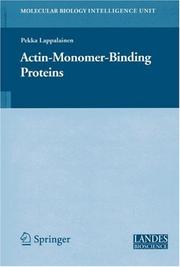
ISBN: 1281512982 9786611512989 0387464077 0387464050 Year: 2007 Publisher: New York, NY : Springer New York : Imprint: Springer,
Abstract | Keywords | Export | Availability | Bookmark
 Loading...
Loading...Choose an application
- Reference Manager
- EndNote
- RefWorks (Direct export to RefWorks)
The actin cytoskeleton plays a central role in many cellular processes including cell motility, cytokinesis, endocytosis and phagocytosis. The structure and dynamics of the actin cytoskeleton is regulated by a large number of proteins that interact with monomeric and/or filamentous actin. Actin monomer binding proteins provides a comprehensive view on actin monomer-binding proteins and the mechanisms by which they contribute to actin dynamics and various actin-dependent cellular processes. This new title contains chapters that describe the basic mechanisms of actin dynamics as well as the structural principles by which various actin-binding proteins interact with actin.
Actin. --- Carrier proteins. --- Binding proteins --- Transport proteins --- Biological transport --- Protein binding --- Proteins --- Actomyosin --- Cytology. --- Biochemistry. --- Cell Biology. --- Biochemistry, general. --- Biological chemistry --- Chemical composition of organisms --- Organisms --- Physiological chemistry --- Biology --- Chemistry --- Medical sciences --- Cell biology --- Cellular biology --- Cells --- Cytologists --- Composition --- Cell biology.
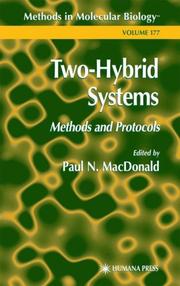
ISBN: 0896038327 0896038084 0585403244 1592592104 1280835931 9786610835935 Year: 2001 Volume: 177 Publisher: Totowa, NJ : Humana Press : Imprint: Humana,
Abstract | Keywords | Export | Availability | Bookmark
 Loading...
Loading...Choose an application
- Reference Manager
- EndNote
- RefWorks (Direct export to RefWorks)
The yeast two-hybrid system is one of the most widely used and productive techniques available for investigating the macromolecular interactions that affect virtually all biological processes. In Two-Hybrid Systems: Methods and Protocols, Paul N. MacDonald has assembled a collection of these powerful molecular tools for examining and characterizing protein-protein, protein-DNA, and protein-RNA interactions. The techniques range from the most basic (introducing plasmids into yeasts, interaction assays, and recovering the plasmids from yeast) to the most advanced alternative strategies (involving one-hybrid, split two-hybrid, three-hybrid, membrane recruitment systems, and mammalian systems). Methods are also provided for dealing with the well-known problems of artifacts and false positives and for identifying the interacting partners in important biological systems, including the Smad and nuclear receptor pathways. To ensure ready reproducibility and robust results, each technique is described in step-by-step detail by researchers who employ it regularly. Comprehensive and highly practical, Two-Hybrid Systems: Methods and Protocols not only reveals how the great variety of plasmid vectors and approaches may be optimally deployed, but also quickly empowers novices to establish two-hybrid systems in their laboratories, and experienced researchers to expand their repertoire of techniques.
Protein binding --- Yeast fungi. --- Plasmids. --- Protéines --- Levures (Botanique) --- Plasmides --- Research --- Methodology. --- Fixation --- Recherche --- Méthodologie --- Protéines --- Méthodologie --- Paragenes --- Yeasts --- Binding, Protein --- Cytoplasmic inheritance --- Genetic vectors --- Mobile genetic elements --- Extrachromosomal DNA --- Fungi --- Basidiomycetes --- Blastomycetes --- Endomycetales --- Biochemistry --- Allosteric proteins --- Radioligand assay --- Cytology. --- Cell Biology. --- Cell biology --- Cellular biology --- Biology --- Cells --- Cytologists
Book
ISBN: 1280618116 9786610618118 3540297847 Year: 2006 Publisher: Berlin, Heidelberg : Springer Berlin Heidelberg : Imprint: Springer,
Abstract | Keywords | Export | Availability | Bookmark
 Loading...
Loading...Choose an application
- Reference Manager
- EndNote
- RefWorks (Direct export to RefWorks)
Gives a survey of the status of the structure, function, regulation and molecular pharmacology of Neurotransmitter Transporters. This book aims to serve as both, a useful compendium of concepts and an inspiring starting point.
Neurotransmitters. --- Carrier proteins. --- Binding proteins --- Transport proteins --- Biological transport --- Protein binding --- Proteins --- Chemical nerve transmitters --- Nerve transmitter substances --- Neural transmitters --- Neurohumors --- Neuroregulators --- Synaptic transmitters --- Transmitters, Chemical nerve --- Transmitters, Synaptic --- Neurochemistry --- Neural transmission --- Neurology. --- Toxicology. --- Pharmacy. --- Neurosciences. --- Cytology. --- Pharmacology/Toxicology. --- Cell Biology. --- Neural sciences --- Neurological sciences --- Neuroscience --- Medical sciences --- Nervous system --- Chemicals --- Medicine --- Pharmacology --- Poisoning --- Poisons --- Neuropsychiatry --- Chemistry --- Drugs --- Materia medica --- Cell biology --- Cellular biology --- Biology --- Cells --- Cytologists --- Toxicology --- Diseases --- Neurology . --- Pharmacology. --- Cell biology. --- Drug effects --- Medical pharmacology --- Chemotherapy --- Pharmacy --- Physiological effect
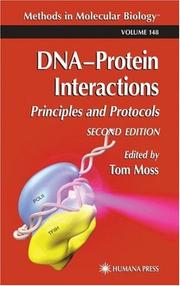
ISBN: 0896036251 0896036715 0585403228 9786610830183 1280830182 1592592082 9780896036710 9780896036253 Year: 2001 Volume: 148 Publisher: Totowa, NJ : Humana Press : Imprint: Humana,
Abstract | Keywords | Export | Availability | Bookmark
 Loading...
Loading...Choose an application
- Reference Manager
- EndNote
- RefWorks (Direct export to RefWorks)
DNA-protein interactions are fundamental to understanding biological growth, development, differentiation, evolution, and disease, and are also increasingly important to the biotechnology industry. In DNA-Protein Interactions: Principles and Protocols, 2nd Edition, Dr. Tom Moss assembles the new standard collection of cutting-edge techniques to identify key protein-DNA interactions, define their components, and determine the nature of their interactions and their manner of function, both in the cell and in the test tube. Each detailed method has been optimized and tested by a hands-on expert to ensure experimental success, and provides helpful notes on pitfalls to avoid, as well as alternate strategies. The techniques span a wide range, from factor identification to atomic detail, and include multiple DNA footprinting analyses, including in vivo strategies, gel shift (EMSA) optimization, SELEX, surface plasmon resonance, site-specific DNA-protein crosslinking, and UV laser crosslinking. There are also vanguard methods for designing proteins to fit DNA, site-specific protein-directed DNA cleavage, and 2D semicrystalline arrays of nucleoproteins for structure determination. Comprehensive and broad ranging, DNA-Protein Interactions: Principles and Protocols, 2nd Edition, offers a stellar array of over 100 up-to-date and readily reproducible techniques that biochemists and molecular, cellular, and developmental biologists can use successfully today to illuminate DNA-protein interactions.
DNA-protein interactions --- DNA-protein interactions. --- Electronic books. -- local. --- Protein binding. --- Nuclease Protection Assays --- Proteins --- Genetic Techniques --- Amino Acids, Peptides, and Proteins --- Investigative Techniques --- Analytical, Diagnostic and Therapeutic Techniques and Equipment --- Chemicals and Drugs --- DNA Footprinting --- DNA-Binding Proteins --- Human Anatomy & Physiology --- Health & Biological Sciences --- Animal Biochemistry --- Life sciences. --- Cell biology. --- Life Sciences. --- Cell Biology. --- Cell biology --- Cellular biology --- Biology --- Cells --- Cytologists --- Biosciences --- Sciences, Life --- Science --- Cytology.
Periodical
Abstract | Keywords | Export | Availability | Bookmark
 Loading...
Loading...Choose an application
- Reference Manager
- EndNote
- RefWorks (Direct export to RefWorks)
Cell Membrane --- Binding Sites. --- Receptors, Cell Surface --- metabolism. --- Binding Site --- Combining Site --- Combining Sites --- Site, Binding --- Site, Combining --- Sites, Binding --- Sites, Combining --- Protein Binding --- Protein Interaction Mapping --- Cell interaction --- Cell metabolism --- Cell membranes --- Cell interaction. --- Cell membranes. --- Cell metabolism. --- Cells --- Metabolism --- Cellular control mechanisms --- Cell surfaces --- Cytoplasmic membranes --- Plasma membranes --- Plasmalemma --- Membranes (Biology) --- Glycocalyces --- Cell-cell interaction --- Cell communication --- Cellular communication (Biology) --- Cellular interaction --- Intercellular communication
| Listing 1 - 10 of 18 | << page >> |
Sort by
|

 Search
Search Feedback
Feedback About
About Help
Help News
News